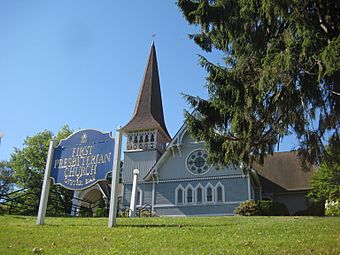First Presbyterian Church of Oyster Bay facts for kids
Quick facts for kids |
|
|
First Presbyterian Church of Oyster Bay
|
|

Oyster Bay Presbyterian Church, 2008
|
|
| Location | E. Main Street, Oyster Bay, New York |
|---|---|
| Area | 1 acre (0.40 ha) |
| Built | 1873 |
| Architect | J. Cleaveland Cady |
| Architectural style | Stick/Eastlake |
| NRHP reference No. | 76001232 |
| Added to NRHP | December 12, 1976 |
The First Presbyterian Church in Oyster Bay, New York, is a historic building that was built in 1873. It is known for its unique architectural style, called Stick/Eastlake. This church is located at 60 East Main Street in Oyster Bay, a town in New York State.
A famous architect named J. Cleaveland Cady designed the church. He was just starting his career when he worked on this building. Later, he designed many other important places, including the original Metropolitan Opera House and parts of the American Museum of Natural History. He also designed buildings at famous universities like Yale University and Trinity College.
This church is special because of its connection to the Roosevelt family. Theodore Roosevelt Sr., his wife Martha Bulloch Roosevelt, and their children, including Theodore Roosevelt Jr. (who later became a President of the United States), were part of this church community. Theodore Roosevelt Sr.'s funeral was held here in 1878. Because of its historical importance, the church building was added to the National Register of Historic Places on December 12, 1976.
Contents
The Church's Story
Early Days of the Congregation
The First Presbyterian Church started its work in Oyster Bay, New York, in 1842. In the beginning, the church community did not have its own building. A pastor from Hempstead, Rev. Mr. Woodbridge, would travel to Oyster Bay to lead services. These services were held at the Oyster Bay Academy or at the Baptist Church on West Main Street.
Building the Church
The first church building was located on East Main Street. It was behind what is now Nobman's Hardware. In the 1850s, the church faced some money problems and could not operate well. However, things improved in the 1860s. By 1872, with pastor Benjamin L. Swan leading the way, the community began building the church we see today. They chose J. Cleaveland Cady as the architect.
Inside the church, you can see beautiful arched entryways. These arches have Bible verses written on them. A special pipe organ, made by Hilborne Roosevelt, was placed at the front of the church. William L. Swan gave this organ to the church and played it for 52 years.
A President's Connection
The future President, Theodore Roosevelt, attended his father's funeral service at this church. He later wrote in his diary about how clearly he remembered seeing his father sitting beside him in the pew. It was as if his father were still alive.
More to Explore



